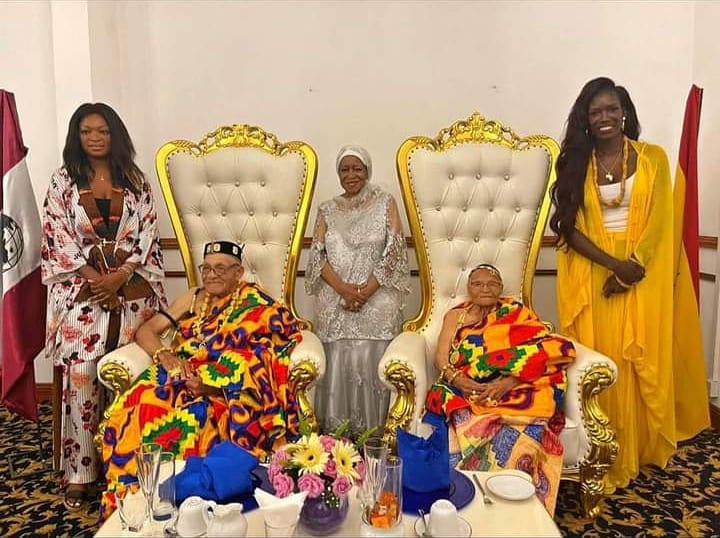
Two African American siblings who survived the 1921 Tulsa massacre arrived in Ghana on Sunday 15th August 2021 for a week-long historic visit.
Accompanied by their grandchildren, Viola Ford Fletcher (aged 107) – also known as ‘Mother Fletcher’ and Van Hughes Ellis (aged 100) – also known as ‘Uncle Redd’ were received at the Kotoka International Airport in the capital Accra by the country’s Deputy Director of Diaspora Affairs, Nadia Adongo Musah and H.E Ambassador Erieka Bennett – Head of Mission of Diaspora African Forum.
The centenarian siblings who touched down in Ghana for the first time were seen beaming with smiles amidst cheers from welcoming onlookers.
Their historic visit is in line with the Ghana government’s ‘Beyond the Return’ campaign which aims at attracting people of African descent to return home and connect with their motherland.
According to the Diaspora African Forum (DAF) Social Media page, “Coming to Ghana was a long lifetime dream for Tulsa Massacre Survivors Mother Viola Fletcher and her brother Uncle Redd.” DAF is the first and only Diplomatic Mission dealing with diaspora issues in the country and beyond. It is also an African Union Commission endorsed non-governmental organization.
On 15th of August 2021, Mother Fletcher and Uncle Redd were hosted by the General overseer of Action Chapel International, Archbishop Nicolas Duncan-Williams and his wife Lady Rosa Whitaker, where they also fellowshipped.
An African Ambassadors Tea was also hosted in their honor by H.E Ambassador Erieka Bennett on 17th of August 2021; graced with several diplomatic Ambassadors from different countries.
The district of Greenwood in the Oklahoma City of Tulsa was well known for its affluent African American community after World War 1. The thriving business district and its surrounding residential area was referred to as the “Black Wall Street.”
Details of the horrific and unfortunate sequence of events are narrated by tulsahistory.org as follows:
“On the morning of May 30, 1921, a young black man named Dick Rowland was riding in the elevator in the Drexel Building at Third and Main with a white woman named Sarah Page. The details of what followed vary from person to person. Accounts of an incident circulated among the city’s white community during the day and became more exaggerated with each telling.
Tulsa police arrested Rowland the following day and began an investigation. An inflammatory report in the May 31 edition of the Tulsa Tribune spurred a confrontation between black and white armed mobs around the courthouse where the sheriff and his men had barricaded the top floor to protect Rowland. Shots were fired and the outnumbered African Americans began retreating to the Greenwood District.”
“In the early morning hours of June 1, 1921, Greenwood was looted and burned by white rioters. Governor Robertson declared martial law, and National Guard troops arrived in Tulsa. Guardsmen assisted firemen in putting out fires, took African Americans out of the hands of vigilantes and imprisoned all black Tulsans not already interned. Over 6,000 people were held at the Convention Hall and the Fairgrounds, some for as long as eight days.”
“Twenty-four hours after the violence erupted, it ceased. In the wake of the violence, 35 city blocks lay in charred ruins, more than 800 people were treated for injuries and contemporary reports of deaths began at 36. Historians now believe as many as 300 people may have died.
In order to understand the Tulsa Race Massacre, it is important to understand the complexities of the times. Dick Rowland, Sarah Page and an unknown gunman were the sparks that ignited a long smoldering fire. Jim Crow, jealousy, white supremacy, and land lust, all played roles in leading up to the destruction and loss of life on May 31 and June 1, 1921.”
“In 2001, an official Race Riot Commission was organized to review the details of the event. No one will ever know the absolute truth of what happened during the hours of the Race Massacre. However, by examining historical resources, members of the Race Riot Commission determined a number of details to be undeniable.”
A Centennial Commission was formed in 2015 to commemorate and create awareness of the massacre; and in 2021; 100 years after, US President Joe Biden said he recognized that “there was a clear effort to erase the event from the nation’s memory.”
By: Theresa R. Fianko
Additional Information: Diaspora African Forum and Tulsa History
Image Attribution: Diaspora African Forum’s Social Media Page
Share this:
RELATED STORIES




